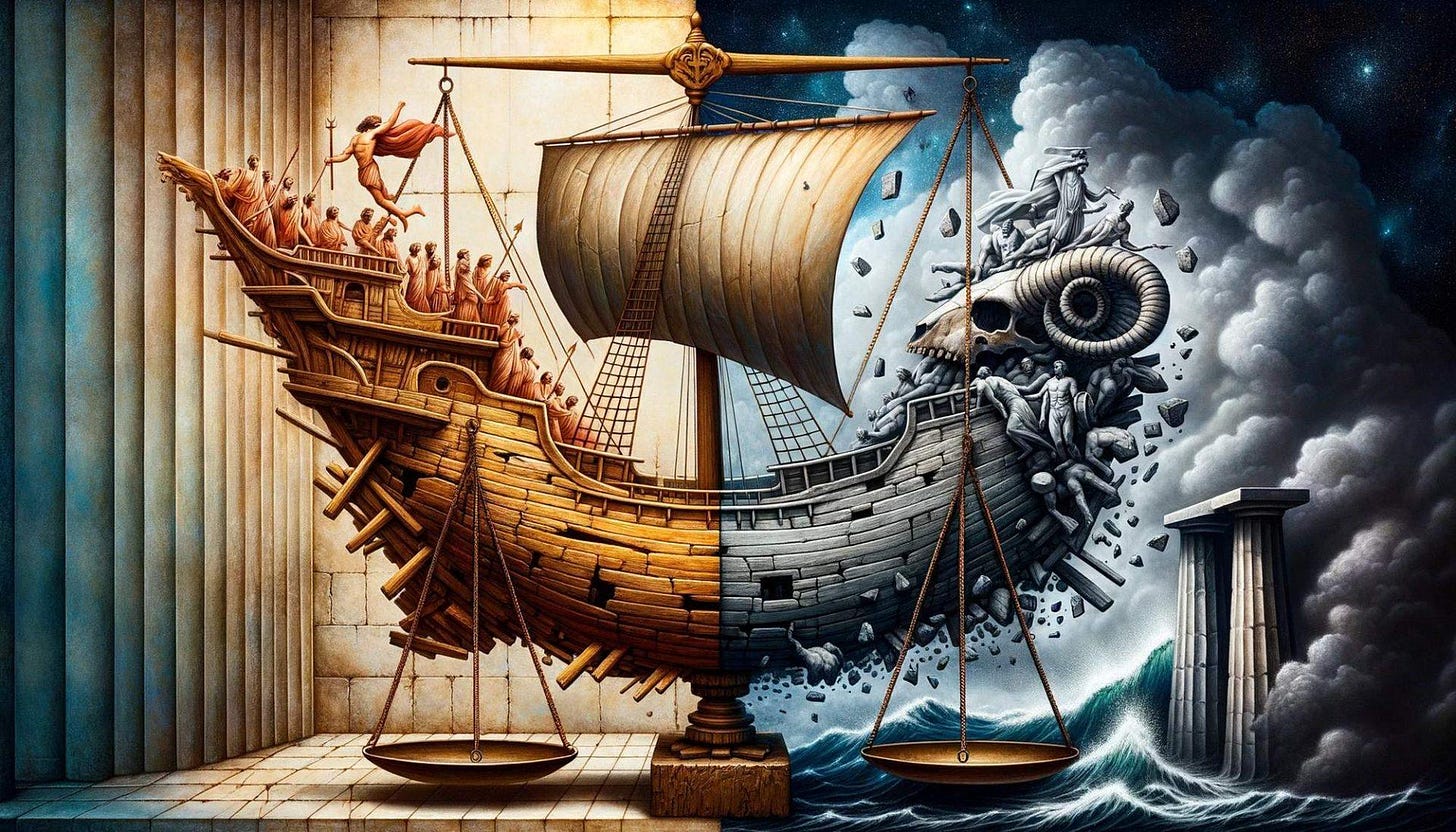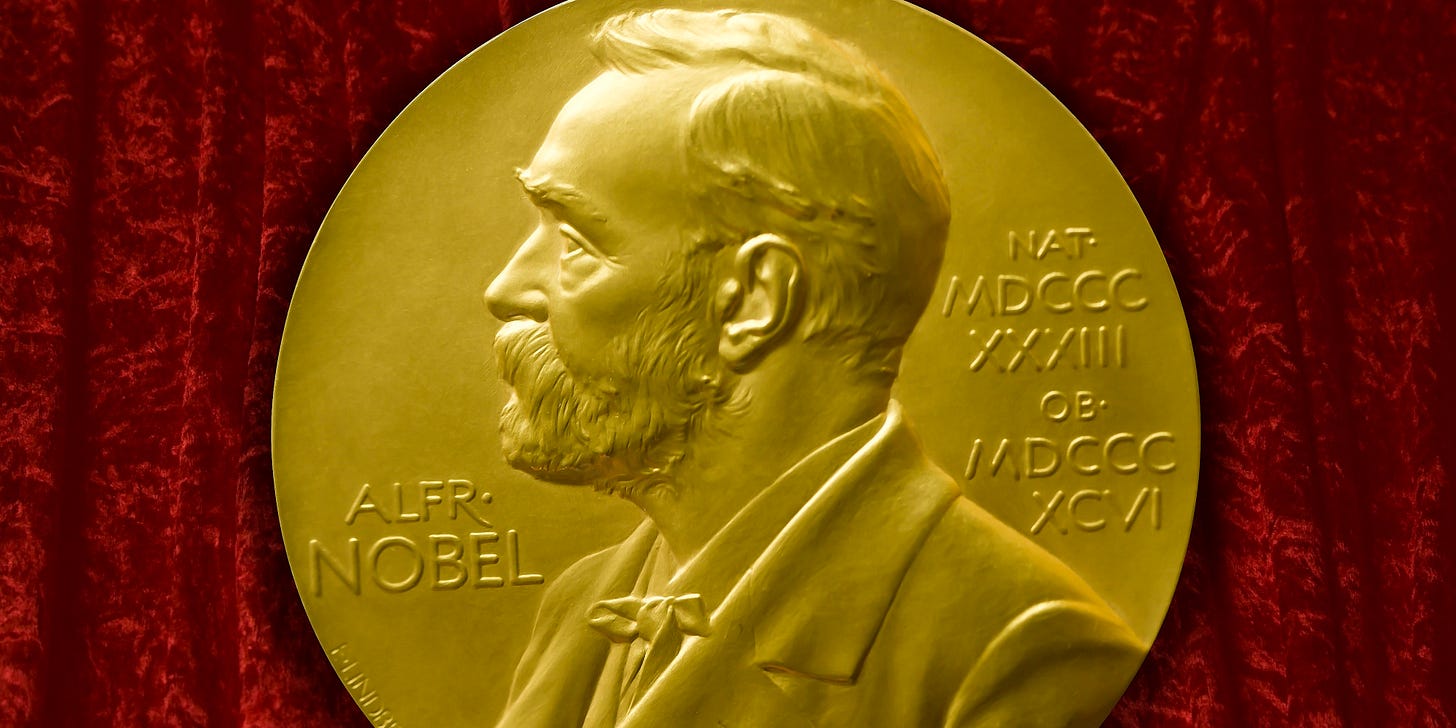When Is a Thing Itself?
Aristotle, X-rays, and Captain Picard
Image: en.jotem.in
The Ship of Theseus is a famous puzzle in metaphysics wherein Theseus, the Greek hero whose travels and travails took years of sailing, performed necessary maintenance on his boat. As wooden planks rotted, they were replaced. A new mast was installed to propel the vessel faster. After a period of time, no part of the ship, not even the structure, remained the same as when they started their adventure. So, the question goes, when it finally pulls back into port in Athens, is this the same ship that left?
The history of science gives us a real-life inverse of this metaphysical question involving the medal awarded to the Nobel laureate Max von Laue. Suppose the material and the form are exactly the same, does that mean it has to be the same object? But what if there had been a radical, but temporary change in it to foil the Nazis?
X-Ray Vision
Max von Laue won the Nobel Prize in physics in 1914 for his work on X-ray crystallography. At the time, we were not sure what this mysterious beam of energy was—which is why we just called it X—and while we were sure that atoms existed thanks to Albert Einstein and Jean Perrin, they were too small to be directly observed and so the study of the way they were put together to build up the things we can see was pretty much a dead end.
But Laue thought that X-rays were an exotic form of light. If this were true, then they should behave like light, for example, bending when passing through a prism. In the case of visible light, we can see it bending, giving us rainbows and the cover of a Pink Floyd album, but to see X-rays, we would need a photographic plate to give us a picture of what came out from the crystal illuminated with the X-rays.
So, Laue and two of his students set up the experiment. They flashed the crystal and developed the film. What came out was a two-dimensional pattern of dark and light patches. This showed that X-rays were a form of light, but even more than that, Laue figured out how to mathematically interpret the resulting pattern to prove that the atomic construction of the crystal was a repeating structure. Laue had solved one mystery and given us the tool to work on another.
It opened the door to a blizzard of new results. For example, Rosalind Franklin and Maurice Wilkins used this technique to provide the data that led to Francis Crick and Jim Watson’s discovery of DNA's double-helical structure, which earned Laue his Nobel Prize.
From Medal to Metal
Image: huffingtonpost.com
About a decade earlier, Laue had been a junior faculty member at the University of Berlin, working with his former dissertation director, Max Planck, the father of Quantum Theory. Planck, who was also editor of the most important physics journal in Germany, had become obsessed with a paper that had been submitted to the journal framing a new theory of motion, a theory of relativity. Being among the most well-connected figures in the field, Planck was baffled that he knew nothing of the author, who hailed from Bern, Switzerland, so he sent Laue to meet the man and report back.
Laue was shocked that the thinker who so impressed the great Planck was not some wizened professor who had spent a lifetime developing a radical idea, but was a young man like himself. The two immediately hit it off and walked the streets of Bern together, excitedly talking about physics. The famous story of this conversation involves Einstein giving Laue one of his cigars so that they could puff as they chat, but Laue found the stogie so foul that he “accidentally” dropped it off of a bridge. This faux pas aside, the two became lifelong friends.
Planck was building the world’s best physics department in Berlin and was ultimately able to lure Einstein there. After World War I, with the ascension of the Nazis, Laue and Einstein were vocal critics. Ultimately, Einstein, like so many others, had to flee Germany. Laue stayed. He thought that the collective irrationality that gave rise to fascism was a short-term illness of the body politic. He was sure the fever would soon break, and morality and sanity would return to society. At that point, someone would need to be there to rebuild the scientific infrastructure.
As World War II started and the situation worsened, the government needed money to fund the war effort. Anything made of gold was seized. Laue looked at his Nobel medal, made of 24-karat gold, and knew it would be taken. So, he had it smuggled from Germany to Denmark, where his colleague and fellow Nobel laureate Neils Bohr would look after it at his institute.
But then, Hitler invaded Denmark. As the Nazis plundered Copenhagen, Bohr needed to do something to save Laue’s medal. A chemist at the institute had an idea and dropped it in a container full of Aqua regia (nitro-hydrochloric acid), which dissolved the medal. On a shelf in the institute sat a sealed jar of liquid with precipitate at the bottom and a piece of tape on the outside that read “Laue.”
After the war, the acid was poured off, and the dissolved gold filtered out. That gold was sent to Sweden where the official goldsmith for the Academy reminted it into the same exact form of Laue’s Nobel medal that he had made when it was initially awarded. Same size, same shape, same mold used, the metal was returned to its original structure, exactly identical.
Aristotle’s Causes
One of the first thinkers to develop a theory of what makes a thing the thing that it is was Aristotle. In his Metaphysics, he argues that if you were to look at something, say a statue, and ask what makes that statue the statue that it is, that is, what causes it to be that statue, then you are actually asking four different questions. The answer to each of those questions is a different sense of the notion of cause.
First, there is the material cause, that is, the stuff it is made of. In the case of our statue, this is the marble it is made of. Without the marble, there would be no statue, so the marble is one cause of it.
Second, there is the shape. This is the formal cause, that is, its form makes it what it is. Change the shape and now it is a different statue.
Third, there is the process that brought it about. In this case, the chiseling of the artist. No artist, no piece of art.
Fourth, there is the final cause, for the sake of which it was created. Maybe it was the love of beauty, maybe the desire to honor a god, maybe it was for money, but there was a reason why that statue was created. Remove the goal that this was a means toward, and the thing would not be.
These are Aristotle’s four causes and for any given thing, he contended, if you can specify them, then you have a complete understanding of the thing in question. But what about the case of Laue’s medal?
Make It So, Number One
Image: pinterest.com
Intuitively, we do not think that it is the same medal but a duplicate. But is it?
To use a more contemporary comparison, it seems that to say that the reminted medal is a different medal would also commit you to saying that every time that captain of the U.S.S. Enterprise used the transporter to beam from the ship to an alien world and back that a different Kirk or Picard walked back on the bridge. But surely, that is the same person, right? So, is it also the same medal?
Let’s see if Aristotle can help us out here.
What makes this puzzle fun is that three of the four of Aristotle’s causes are clearly identical before and after in both cases.
The material causes of the medal and Captain Kirk are the same. The gold used in reminting the medal came from dissolving the original, and anything other than the gold was filtered out. Similarly, the very atoms that made up the Captain who left were disassembled and reassembled.
The formal causes of both are the same. By using the same mold and the same artist, the reminted medal would be the same exact shape as the original. And the Picard that beams back has the same look, the same body parts, even the same memories so even the neural structure must be invariant.
The final causes are the same. The purpose of the medal was to celebrate the work of Max von Laue, which did not change. Similarly, for either captain, they could still boldly go where no one had gone before subject to the same Prime Directive.
The tricky one is the efficient cause.
It was the same goldsmith that shaped the medal both times…but they were two different times. Doesn’t this mean that while the two medals have similar efficient causes, they do not have the same efficient cause?
Similarly, with the Captain. It was Kirk’s parents who did something anatomical that Kirk seemed to regularly do with attractive aliens that led to his creation. That is surely not what Scotty was doing in the transporter room. In reassembling his Captain, Scotty is an engineer serving under Kirk, not a new parent of him.
So, it seems that the two cases must be different in some way, and the only possibility seems to be the efficient cause. Could it be that the medal is an artifact, a human construction that came from the design of an artist, whereas the captains of the Enterprise are organic beings that developed biologically? Are natural causes different from human intentions, given that the human brain is itself an organic object? Or are people and our choices a different category of cause?
As is the case with so much good philosophy, we leave the question with the reader. Is the reminted medal the same medal as the one originally presented to Laue? Are the pre- and post-beamed captains the same person? Are these cases different, and if so, why?
Answers should be four pages, typed in 12 pt. Times New Roman, with your name on the top. We will have them graded with comments in a couple weeks. This should be your own work, do not use ChatGPT.
Click here to register 👇









